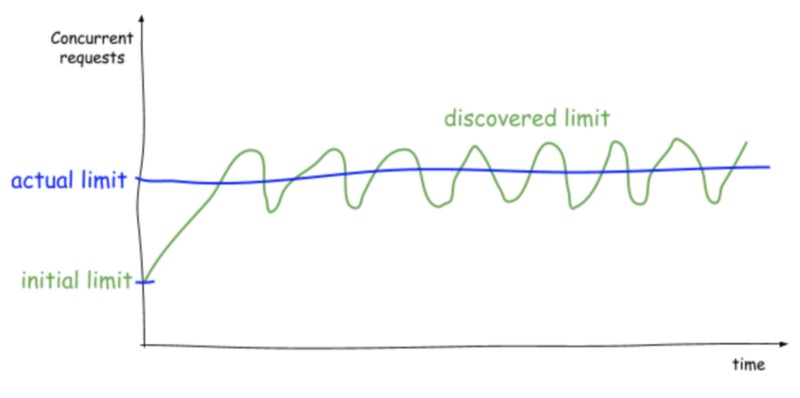自适应限流都用什么牛逼工具?
Written on: Mei 20, 2021
Title : 自适应限流都用什么牛逼工具?
link : 自适应限流都用什么牛逼工具?
自适应限流都用什么牛逼工具?
作者:fredalxin
地址:https://fredal.xin/netflix-concuurency-limits
作为应对高并发的手段之一,限流并不是一个新鲜的话题了。从Guava的Ratelimiter到Hystrix,以及Sentinel都可作为限流的工具。
自适应限流
一般的限流常常需要指定一个固定值(qps)作为限流开关的阈值,这个值一是靠经验判断,二是靠通过大量的测试数据得出。但这个阈值,在流量激增、系统自动伸缩或者某某commit了一段有毒代码后就有可能变得不那么合适了。并且一般业务方也不太能够正确评估自己的容量,去设置一个合适的限流阈值。
而此时自适应限流就是解决这样的问题的,限流阈值不需要手动指定,也不需要去预估系统的容量,并且阈值能够随着系统相关指标变化而变化。
自适应限流算法借鉴了TCP拥塞算法,根据各种指标预估限流的阈值,并且不断调整。大致获得的效果如下:

从图上可以看到,首先以一个降低的初始并发值发送请求,同时通过增大限流窗口来探测系统更高的并发性。而一旦延迟增加到一定程度了,又会退回到较小的限流窗口。循环往复持续探测并发极限,从而产生类似锯齿状的时间关系函数。
TCP Vegas
vegas是一种主动调整cwnd的拥塞控制算法,主要是设置两个阈值alpha 和 beta,然后通过计算目标速率和实际速率的差diff,再比较差diff与alpha和beta的关系,对cwnd进行调节。伪代码如下:
diff = cwnd*(1-baseRTT/RTT)if (diff < alpha)set: cwnd = cwnd + 1 else if (diff >= beta)set: cwnd = cwnd - 1elseset: cwnd = cwnd其中baseRTT指的是测量的最小往返时间,RTT指的是当前测量的往返时间,cwnd指的是当前的TCP窗口大小。通常在tcp中alpha会被设置成2-3,beta会被设置成4-6。这样子,cwnd就保持在了一个平衡的状态。
netflix-concuurency-limits
concuurency-limits是netflix推出的自适应限流组件,借鉴了TCP相关拥塞控制算法,主要是根据请求延时,及其直接影响到的排队长度来进行限流窗口的动态调整。
alpha , beta & threshold
vegas算法实现在了VegasLimit类中。先看一下初始化相关代码:
private int initialLimit = 20;private int maxConcurrency = 1000;private MetricRegistry registry = EmptyMetricRegistry.INSTANCE;private double smoothing = 1.0;private Function<Integer, Integer> alphaFunc = (limit) -> 3 * LOG10.apply(limit.intValue());private Function<Integer, Integer> betaFunc = (limit) -> 6 * LOG10.apply(limit.intValue());private Function<Integer, Integer> thresholdFunc = (limit) -> LOG10.apply(limit.intValue());private Function<Double, Double> increaseFunc = (limit) -> limit + LOG10.apply(limit.intValue());private Function<Double, Double> decreaseFunc = (limit) -> limit - LOG10.apply(limit.intValue());这里首先定义了一个初始化值initialLimit为20,以及极大值maxConcurrency1000。其次是三个
阈值函数alphaFunc,betaFunc以及thresholdFunc。最后是两个增减函数increaseFunc和decreaseFunc。
函数都是基于当前的并发值limit做运算的。
- alphaFunc可类比vegas算法中的alpha,此处的实现是3*log limit。limit值从初始20增加到极大1000时候,相应的alpha从3.9增加到了9。
- betaFunc则可类比为vegas算法中的beta,此处的实现是6*log limit。limit值从初始20增加到极大1000时候,相应的alpha从7.8增加到了18。
- thresholdFunc算是新增的一个函数,表示一个较为初始的阈值,小于这个值的时候limit会采取激进一些的增量算法。这里的实现是1倍的log limit。mit值从初始20增加到极大1000时候,相应的alpha从1.3增加到了3。
这三个函数值可以认为确定了动态调整函数的四个区间范围。当变量queueSize = limit × (1 − RTTnoLoad/RTTactual)落到这四个区间的时候应用不同的调整函数。
变量queueSize
其中变量为queueSize,计算方法即为limit × (1 − RTTnoLoad/RTTactual),为什么这么计算其实稍加领悟一下即可。

我们把系统处理请求的过程想象为一个水管,到来的请求是往这个水管灌水,当系统处理顺畅的时候,请求不需要排队,直接从水管中穿过,这个请求的RT是最短的,即RTTnoLoad;
反之,当请求堆积的时候,那么处理请求的时间则会变为:排队时间+最短处理时间,即RTTactual = inQueueTime + RTTnoLoad。而显然排队的队列长度为
总排队时间/每个请求的处理时间及queueSize = (limit * inQueueTime) / (inQueueTime + RTTnoLoad) = limit × (1 − RTTnoLoad/RTTactual)。
再举个栗子,因为假设当前延时即为最佳延时,那么自然是不用排队的,即queueSize=0。而假设当前延时为最佳延时的一倍的时候,可以认为处理能力折半,100个流量进来会有一半即50个请求在排队,及queueSize= 100 * (1 − 1/2)=50。
动态调整函数
调整函数中最重要的即增函数与减函数。从初始化的代码中得知,增函数increaseFunc实现为limit+log limit,减函数decreaseFunc实现为limit-log limit,相对来说增减都是比较保守的。
看一下应用动态调整函数的相关代码:
private int updateEstimatedLimit(long rtt, int inflight, boolean didDrop) { final int queueSize = (int) Math.ceil(estimatedLimit * (1 - (double)rtt_noload / rtt)); double newLimit; // Treat any drop (i.e timeout) as needing to reduce the limit // 发现错误直接应用减函数decreaseFunc if (didDrop) { newLimit = decreaseFunc.apply(estimatedLimit); // Prevent upward drift if not close to the limit } else if (inflight * 2 < estimatedLimit) { return (int)estimatedLimit; } else { int alpha = alphaFunc.apply((int)estimatedLimit); int beta = betaFunc.apply((int)estimatedLimit); int threshold = this.thresholdFunc.apply((int)estimatedLimit); // Aggressive increase when no queuing if (queueSize <= threshold) { newLimit = estimatedLimit + beta; // Increase the limit if queue is still manageable } else if (queueSize < alpha) { newLimit = increaseFunc.apply(estimatedLimit); // Detecting latency so decrease } else if (queueSize > beta) { newLimit = decreaseFunc.apply(estimatedLimit); // We're within he sweet spot so nothing to do } else { return (int)estimatedLimit; } } newLimit = Math.max(1, Math.min(maxLimit, newLimit)); newLimit = (1 - smoothing) * estimatedLimit + smoothing * newLimit; if ((int)newLimit != (int)estimatedLimit && LOG.isDebugEnabled()) { LOG.debug("New limit={} minRtt={} ms winRtt={} ms queueSize={}", (int)newLimit, TimeUnit.NANOSECONDS.toMicros(rtt_noload) / 1000.0, TimeUnit.NANOSECONDS.toMicros(rtt) / 1000.0, queueSize); } estimatedLimit = newLimit; return (int)estimatedLimit;}动态调整函数规则如下:
- 当变量queueSize < threshold时,选取较激进的增量函数,newLimit = limit+beta
- 当变量queueSize < alpha时,需要增大限流窗口,选择增函数increaseFunc,即newLimit = limit + log limit
- 当变量queueSize处于alpha,beta之间时候,limit不变
- 当变量queueSize大于beta时候,需要收拢限流窗口,选择减函数decreaseFunc,即newLimit = limit - log limit
平滑递减 smoothingDecrease
注意到可以设置变量smoothing,这里初始值为1,表示平滑递减不起作用。
如果有需要的话可以按需设置,比如设置smoothing为0.5时候,那么效果就是采用减函数decreaseFunc时候效果减半,实现方式为newLimitAfterSmoothing = 0.5 newLimit + 0.5 limit。
近期热文推荐:
1.600+ 道 Java面试题及答案整理(2021最新版)
2.终于靠开源项目弄到 IntelliJ IDEA 激活码了,真香!
3.阿里 Mock 工具正式开源,干掉市面上所有 Mock 工具!
4.Spring Cloud 2020.0.0 正式发布,全新颠覆性版本!
5.《Java开发手册(嵩山版)》最新发布,速速下载!
觉得不错,别忘了随手点赞+转发哦!
原文转载:http://www.shaoqun.com/a/753798.html
网上1号店:https://www.ikjzd.com/w/2263
ryder:https://www.ikjzd.com/w/1264.html
作者:fredalxin地址:https://fredal.xin/netflix-concuurency-limits作为应对高并发的手段之一,限流并不是一个新鲜的话题了。从Guava的Ratelimiter到Hystrix,以及Sentinel都可作为限流的工具。自适应限流一般的限流常常需要指定一个固定值(qps)作为限流开关的阈值,这个值一是靠经验判断,二是靠通过大量的测试数据得出。但这个阈
雨果网:https://www.ikjzd.com/w/1307
邮政电话:https://www.ikjzd.com/w/202
landing:https://www.ikjzd.com/w/2368
涨姿势!Yuki对亚马逊Vine的新认知:https://www.ikjzd.com/articles/134425
速卖通卖家须知,oberlo+shopify的使用教程:https://www.ikjzd.com/articles/18265
口述:中年妻子出轨后开始扮嫩:http://lady.shaoqun.com/m/a/272324.html
That's the article 自适应限流都用什么牛逼工具?
You are now reading the article 自适应限流都用什么牛逼工具? with link address https://southafrica-update.blogspot.com/2021/05/blog-post.html
